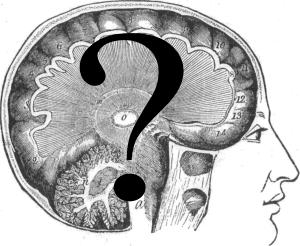 Can we, one day, understand how the neurology of the brain leads to conscious minds, or will that remain impossible?
Can we, one day, understand how the neurology of the brain leads to conscious minds, or will that remain impossible?
Round here we mostly discuss the mind from a top-down, philosophical perspective; but there is another way, which is to begin by understanding the nuts and bolts and then gradually working up to more complex processes. This Scientific American piece gives a quick view of how research at the neuronal level is coming along (quite well, but with vastly more to do).
Is this ever going to tell us about consciousness, though? A point often quoted by pessimists is that we have had the complete ‘wiring diagram’ of the roundworm Caenorhabditis elegans for years (Caenorhabditis has only just over 300 neurons and they have all been mapped) but still cannot properly explain how it works. Apparently researchers have largely given up on this puzzle for now. Perhaps Caenorhabditis is just too simple; its nervous system might be quirky or use elegant but opaque tricks that make it particularly difficult to fathom. Instead researchers are using fruit fly larvae and other creatures with nervous systems that are simple enough to deal with, but large enough to suggest that they probably work in a generic way, one that is broadly standard for all nervous systems up to and including the human. With modern research techniques this kind of approach is yielding some actual progress.
How optimistic can we be, though? We can never understand the brain by knowing the simultaneous states of all its neurons, so the hope of eventual understanding rests on the neurology of the brain being legible at some level. We hope there will turn out to be functions that get repeated, that firm building blocks of some intelligible structure; that we will be able to deduce rules or a kind if grammar which will let us see how things work on a slightly higher level of description.
This kind of structure is built into machines and programs; they are designed to be legible by human beings and lend themselves to reverse engineering. But the brain was not designed and is under no obligation to construct itself according to regular plans and principles. Our hope that it won’t turn out to be a permanently incomprehensible tangle rests on several possibilities.
First, it might just turn out to be like that. The computer metaphor encourages us to think that the brain must encode its information in regular ways (though the lack of anything strongly analogous to software is arguably a fly in the ointment). Perhaps we’ll just get lucky. When the structure of DNA was discovered, it really seemed as if we’d had a stroke of luck of this kind. What amounted to a long string of four repeated characters, ones that given certain conditions could be read as coding for many different proteins; it looked like we had a really clear legible system of very general significance. It still does to a degree, but my impression is that the glad confident morning is over, and now the more we learn about genetics the more complex and messy it gets. But even if we take it that genetics is a perfect example of legibility, there’s no particular reason to think that the connectome will be as tractable as the genome.
The second reason to be cheerful is that legibility might flow naturally from function. That is, after all, pretty much what happens with organs other than the brain. The heart is not mysterious, because it has a clear function and its structure is very legible in engineering terms in the light of that function. The brain is a good deal more complex than that, but on the other hand we already know of neurons and groups of neurons that do intelligibly carry out functions in our sensory or muscular systems.
There are big problems when it comes to the higher cognitive functions though. First, we don’t already understand consciousness the way we already understand pumps and levers. When it comes to the behaviour of fruit fly larvae, even, we can relate inputs and outputs to neural activity in a sensible way. For conscious thought it may be difficult to tell which neurons are doing it without already knowing what it is they’re doing. It helps a lot that people can tell us about conscious experience, though when it comes to subjective, qualities experience we have to remember that Zombie Twin tells us about his experiences too, though he doesn’t have any. (Then again, since he’s the perfect counterpart of a non-zombie, how much does it matter?)
Second, conscious processing is clearly non-generic in a way that nothing else in our bodies appears to be. Muscle fibres contract, and one does it much like another. Our lungs oxygenate our blood, and there’s no important difference between bronchi. Even our gut behaves pretty generically; it copes magnificently with a bizarre variety of inputs, but it reduces them all to the same array of nutrients and waste.
The conscious mind is not like that. It does not secrete litres of undifferentiated thought, producing much the same stuff every day and whatever we feed it with. On the contrary, its products are minutely specific – and that is the whole point. The chances of our being able to identify a standard thought module, the way we can identify standard functions elsewhere, are correspondingly slight as a result.
Still, one last reason to be cheerful; one thing the human brain is exceptionally good at is intuiting patterns from observations; far better than it has any right to be. It’s not for nothing that ‘seeing’ is literally the verb fir vision and metaphorically the verb for understanding. So exhibiting patterns of neural activity might just be the way to trigger that unexpected insight that opens the problem out…
